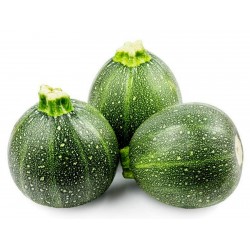Menu
-
MenuНазад
- Home
-
Категорії
-
-
Категорії
-
Насіння овочів
-
Сорти за країнами
- Сорти з Вірменії
- Сорти з БіГ
- Сорти з Хорватії
- Сорти з Франції
- Varieties from Germany
- Varieties from Greece
- Varieties from Hungary
- Сорти з Індії
- Varieties from Italy
- Сорти з Японії
- Сорти з Північної Македонії
- Varieties from Peru
- Varieties from Russia
- Varieties from Serbia
- Сорти зі Словенії
- Varieties from Spain
- Varieties from Thailand
- Сорти з Туреччини
- Varieties from USA
- Насіння томатів
- Насіння кукурудзи
- Сімейство гарбузових
- Родина бобових
- Насіння огірків
- Насіння болгарського перцю
- Сім'я морквяних
- Родина цибулевих
- Насіння салату
- Родина картопляних
- Сімейство капустяних
- Насіння редьки
- Родина бурякових
- Насіння кавуна
- Насіння дині
- Насіння цвітної капусти
- Родина соняшникових
-
Сорти за країнами
- Насіння фруктів
- Насіння перцю чилі
- Насіння лікарських трав
- Насіння рослин лазіння
- Дерева - Чагарник - Насіння
- Пальмове насіння
- Насіння декоративних трав
- Насіння тютюну
-
Насіння овочів
-
-
-
-
- НОВІ ПРОДУКТИ
- Доставка - Оплата
- Створити рахунок
- FAQ
Список товарів за брендом Seeds Gallery
Seeds produced by Seeds Gallery
Seeds produced by Seeds Gallery
Знайдено товарів: 408.
Показати 397-408 з 408 товарів

Разнообразие из Америки
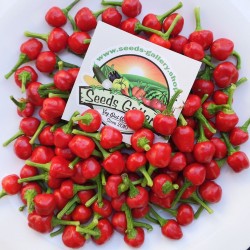
Насіння чилі West Virginia Pea
Ціна
1,95 €
SKU: C 88
Seeds Gallery Com,
5/
5
<!DOCTYPE html>
<html>
<head>
<meta http-equiv="Content-Type" content="text/html; charset=UTF-8" />
</head>
<body>
<h2><strong>Насіння чилі West Virginia Pea</strong></h2>
<h2><span style="color: #ff0000;"><strong>Ціна за упаковку з 10 насінин.</strong></span></h2>
<p>85 днів. Capsicum annuum. Відкрите запилення. Рослина дає хороший урожай завширшки 2 "широкого гострого перцю довжиною 2 см. Перець гострий, росте вертикально гронами, має м’якоть середньої товщини і переходить від зеленого до зеленого з фіолетовими позначками до червоного, коли дозріє.</p>
<p>Рослина має зелене листя, зелені стебла з фіолетовими позначками та білі квіти. Красива їстівна декоративна рослина перцю.</p>
<p>Прекрасний сушильний перець і чудово підходить для приготування порошку спецій для приправ.</p>
<p>Різновид із Західної Вірджинії, США.</p>
</body>
</html>
C 88


Это растение является лекарственным растением
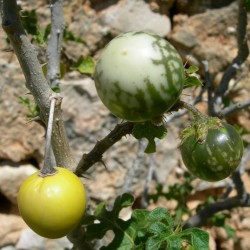
Насіння Яблуко диявола...
Ціна
1,95 €
SKU: F 70
Seeds Gallery Com,
5/
5
<h2><strong>Насіння Яблуко диявола (Solanum linnaeanum)</strong></h2>
<h2><span style="color: #fe0000;"><strong>Ціна за упаковку 10 насінин.</strong></span></h2>
<p>Багаторічна рослина, чагарник висотою 0.5–1.5 (–2,5) м. Шипи розташовані в усіх наземних органах рослини, за винятком квітів і плодів. Листя яйцеподібне або широкояйцеподібне, глибоко розсічене, довжиною від 5 до 12.5 см, й від 2.8 до 8 сантиметрів завширшки. Гермафродитні квіти ростуть поодиноко або в суцвіттях. Віночок від 20 до 30 мм в діаметрі, фіолетовий, з п'ятьма пелюстками; є 5 тичинок з жовтими пильовиками. Цвіте протягом року. М'ясисті ягоди 3–5 см, жовті в кінці терміну дозрівання. Насіння від коричневого до чорного кольору і від 2,9 до 3,5 мм в довжину.<br><br>Поширення<br>Південна Африка: Мозамбік; Зімбабве; ПАР. Натуралізований: Африка: Еритрея. Австралазія: Австралія; Нова Зеландія. Південна Європа: Албанія; Болгарія; Хорватія; Греція; Італія; Франція — Корсика; Португалія [вкл. Азорські, Мадейра]; Гібралтар; Іспанія. Тихоокеанський регіон: Сполучені Штати — Гаваї; Фіджі; Нова Каледонія. Населяє узбіччя, покинуті будинки, звалища, прибережні зони, кам'янисті місця.<br><br>Використання<br>Отруйна рослина. Використовується для приготування фармацевтичних препаратів для лікування пухлин.</p>
<script src="//cdn.public.n1ed.com/G3OMDFLT/widgets.js"></script>
F 70 (10 S)


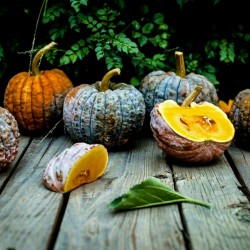
Насіння японського гарбуза...
Ціна
2,35 €
SKU: VG 31
Seeds Gallery Com,
5/
5
<h2><strong>Насіння японського гарбуза BLACK FUTSU</strong></h2>
<h2><span style="color: #ff0000;"><strong>Ціна за упаковку з 5 насіння.</strong></span></h2>
Рідкісний, чорний японський кабачок, плід сплюснутий, округлий, з сильними ребрами. Дуже унікальна і красива. При зберіганні чорний плід придбає насичений каштановий колір. М’якоть золотистого кольору з насиченим смаком лісових горіхів. Плоди 3-5 фунтів (1-3,5 кг). кожна, а лози дають величезні врожаї. Японець, смаглявий, сплюснутий, впорався тут чудово. Популярний серед виробників європейського ринку. Хороша стійкість до комах робить це переможцем!<br /><br />(C. moschata) 105 днів
<script src="//cdn.public.n1ed.com/G3OMDFLT/widgets.js"></script>
VG 31 (5 S)

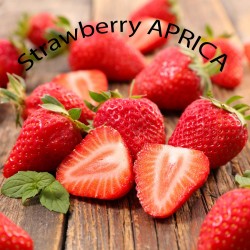
Полуничне насіння 2 в 1...
Ціна
1,95 €
SKU: V 1 MIX CA
Seeds Gallery Com,
5/
5
<h2 class=""><strong>Полуничне насіння 2 в 1 CLERY + APRICA</strong></h2>
<h2><span style="color: #ff0000;"><strong>Ціна за упаковку 200 (0,12 г) насіння.</strong></span></h2>
<p><strong>АПРИКА</strong><br>Середньоранній сорт, придатний для європейського континентального клімату.<br>Злегка пишна рослина, дуже стійка до хвороб, особливо борошнистої роси. Вертикальна рослина розвиває квіти під листям. Високопродуктивний сорт з дуже привабливими та великими плодами правильної конічної форми, які є великими протягом усього періоду збору врожаю. Плоди тверді і мають чудовий термін зберігання. Вони є яскравими і стабільними кольорами, яких вони досягають як за відсутності світла, так і при більш низьких температурах. Хороша стійкість до дощових сортів. Дуже смачно, з оптимальним співвідношенням цукру та кислот. Будова самої рослини та цвітіння значно полегшує урожай. Дозріває через 4 дні після Клірі.<br><br><strong>КЛЕРІ</strong><br>Дуже ранній сорт з початку травня<br>Середньо пишна рослина, дуже стійка і толерантна до хвороб листя і коренів. Листя середнього розміру, світло-зелені, квітка нижча або на висоті листя, плоди великі, конічної форми, яскраво-червоного кольору, твердої твердості, хорошого смаку та аромату. Це дає чудові врожаї, а врожайність з рослини в середньому становить 750 грам. Дозріває рано (кінець квітня - початок травня).<br>Полуниця добре переносить транспорт після збору врожаю.<br><br>Толерантний до хвороб листя та коренів.</p>
<p><strong><a href="https://www.seeds-gallery.shop/en/home/how-to-grow-strawberries-from-seed.html">How to Grow Strawberries from Seeds</a></strong></p>
<script src="//cdn.public.n1ed.com/G3OMDFLT/widgets.js"></script>
V 1 MIX CA

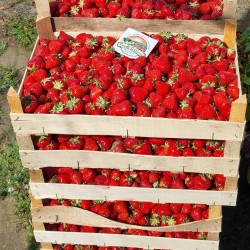
Полуничне насіння APRICA
Ціна
2,45 €
SKU: V 1 AP
Seeds Gallery Com,
5/
5
<h2><strong>Полуничне насіння APRICA</strong></h2>
<h2><span style="color: #ff0000;"><strong>Ціна за упаковку 200 (0,12 г) насіння.</strong></span></h2>
<p class=""><strong>АПРИКА</strong><br>Середньоранній сорт, придатний для європейського континентального клімату.<br>Злегка пишна рослина, дуже стійка до хвороб, особливо борошнистої роси. Вертикальна рослина розвиває квіти під листям. Високопродуктивний сорт з дуже привабливими та великими плодами правильної конічної форми, які є великими протягом усього періоду збору врожаю. Плоди тверді і мають чудовий термін зберігання. Вони є яскравими і стабільними кольорами, яких вони досягають як за відсутності світла, так і при більш низьких температурах. Хороша стійкість до дощових сортів. Дуже смачно, з оптимальним співвідношенням цукру та кислот. Будова самої рослини та цвітіння значно полегшує урожай. Дозріває через 4 дні після Клірі.</p>
<p><strong><a href="https://www.seeds-gallery.shop/en/home/how-to-grow-strawberries-from-seed.html">How to Grow Strawberries from Seeds</a></strong></p>
<script src="//cdn.public.n1ed.com/G3OMDFLT/widgets.js"></script>
V 1 AP (0.12g)


Разнообразие из Сербии
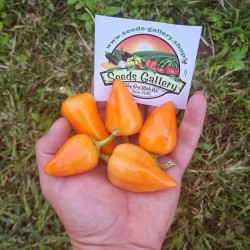
Помаранчева піраміда...
Ціна
1,95 €
SKU: C 48
Seeds Gallery Com,
5/
5
<h2><strong>Помаранчева піраміда насіння чилі</strong></h2>
<h2><span style="color: #ff0a0a;"><strong>Ціна за упаковку з 20 насінин.</strong></span></h2>
Цей м'який перець чилі належить до сімейства C. Anum. Рослини є високопродуктивними і забезпечують масу плодів вагою близько 21 грам на один плід і довжиною від 3 до 6 сантиметрів.<br><br>Відмінний сорт як для свіжого вживання, так і для сушіння, або для приготування їжі на зиму (маринований, маринований перець ...)<br><br>Один з улюблених сортів Сербії для приготування фаршированого перцю з сиром.<script src="//cdn.public.n1ed.com/G3OMDFLT/widgets.js"></script>
C 48 (20 S)


Разнообразие из Сербии
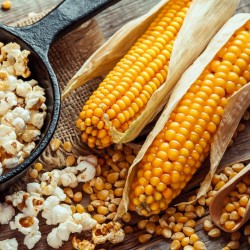
Попкорн 50 насінин -...
Ціна
1,95 €
SKU: VE 104
Seeds Gallery Com,
5/
5
<h2 class=""><strong>Попкорн 50 насінин - вирощуйте самі</strong><br><span style="color: #ff0000;"><strong>Ціна за упаковку 50 (10г) насіння.</strong></span></h2>
<p>100% NATURAL POPCORN</p>
<p>NON-GMO, NOT GENETICALLY MODIFIED. SIMPLY PURE AND NATURAL!</p>
<p><b>Popcorn</b><span> </span>(<b>popped corn</b>,<span> </span><b>popcorns</b><span> </span>or<span> </span><b>pop-corn</b>) is a variety of<span> </span>corn<span> </span>kernel, which expands and puffs up when heated.</p>
<p>A popcorn kernel's strong hull contains the seed's hard, starchy<span> </span>endosperm<span> </span>with 14–20% moisture, which turns to steam as the kernel is heated.<span> </span>Pressure<span> </span>from the steam continues to build until the hull ruptures, allowing the kernel to forcefully expand from 20 to 50 times its original size—and finally, cool.<sup id="cite_ref-ref5_1-0" class="reference">[1]</sup></p>
<p>Some<span> </span>strains<span> </span>of corn (taxonomized as<span> </span><i>Zea mays</i>) are cultivated specifically as popping corns. The<span> </span><i>Zea mays</i><span> </span>variety<span> </span><i>everta,</i><span> </span>a special kind of<span> </span>flint corn, is the most common of these.</p>
<p>The six major types of corn are<span> </span>dent corn,<span> </span>flint corn,<span> </span>pod corn, popcorn,<span> </span>flour corn, and<span> </span>sweet corn.<sup id="cite_ref-2" class="reference"></sup></p>
<h2><span class="mw-headline" id="History">History</span></h2>
<p>Corn was first domesticated about 10,000 years ago in what is now<span> </span>Mexico.<sup id="cite_ref-3" class="reference">[3]</sup><span> </span>Archaeologists discovered that people have known about popcorn for thousands of years. In Mexico, for example, remnants of popcorn have been found that date to around 3600 BC.<sup id="cite_ref-4" class="reference">[4]</sup></p>
<p>Popping of the kernels was achieved by hand on the stove-top through the 19th century. Kernels were sold on the<span> </span>East Coast of the United States<span> </span>under names such as<span> </span><i>Pearls</i><span> </span>or<span> </span><i>Nonpareil</i>. The term<span> </span><i>popped corn</i><span> </span>first appeared in<span> </span>John Russell Bartlett's 1848<span> </span><i>Dictionary of Americanisms</i>.<sup id="cite_ref-:1_5-0" class="reference">[5]</sup><sup id="cite_ref-6" class="reference">[6]</sup><span> </span>Popcorn is an ingredient in<span> </span>Cracker Jack, and in the early years of the product, it was popped by hand.<sup id="cite_ref-:1_5-1" class="reference">[5]</sup></p>
<div class="thumb tleft">
<div class="thumbinner"><img alt="Popcorn seeds - Grow your own Price for Package of 100 seeds. " src="https://upload.wikimedia.org/wikipedia/en/thumb/e/ec/Improved_no2_Wagon.jpg/170px-Improved_no2_Wagon.jpg" class="thumbimage" title="Popcorn seeds - Grow your own Price for Package of 100 seeds. " width="170" height="204">
<div class="thumbcaption">
<div class="magnify"></div>
An early popcorn machine in a street cart, invented in the 1880s by Charles Cretors in Chicago.</div>
</div>
</div>
<p>Popcorn's accessibility increased rapidly in the 1890s with Charles<span> </span>Cretors' invention of the popcorn maker. Cretors, a Chicago candy store owner, created a number of steam-powered machines for roasting nuts and applied the technology to the corn kernels. By the turn of the century, Cretors had created and deployed street carts equipped with steam-powered popcorn makers.<sup id="cite_ref-:0_7-0" class="reference">[7]</sup></p>
<p>During the<span> </span>Great Depression, popcorn was fairly inexpensive at 5–10 cents a bag and became popular. Thus, while other businesses failed, the popcorn business thrived and became a source of income for many struggling farmers, including the Redenbacher family, namesake of the<span> </span>famous popcorn brand. During<span> </span>World War II, sugar<span> </span>rations<span> </span>diminished<span> </span>candy<span> </span>production, and Americans compensated by eating three times as much popcorn as they had before.<sup id="cite_ref-popcorn.org_8-0" class="reference">[8]</sup><span> </span>The snack was popular at theaters, much to the initial displeasure of many of the theater owners, who thought it distracted from the films. Their minds eventually changed, however, and in 1938 a Midwestern theater owner named Glen W. Dickson installed popcorn machines in the lobbies of his theaters. The venture was a financial success, and the trend soon spread.<sup id="cite_ref-:1_5-2" class="reference">[5]</sup></p>
<div class="thumb tright">
<div class="thumbinner"><img alt="Popcorn seeds - Grow your own Price for Package of 100 seeds. " src="https://upload.wikimedia.org/wikipedia/commons/thumb/f/f5/Gangnaengi_%28Korean_popcorn%29.jpg/220px-Gangnaengi_%28Korean_popcorn%29.jpg" class="thumbimage" title="Popcorn seeds - Grow your own Price for Package of 100 seeds. " width="220" height="159">
<div class="thumbcaption">
<div class="magnify"></div>
<i>gangnaengi</i>, Korean popcorn</div>
</div>
</div>
<p>In 1970,<span> </span>Orville Redenbacher's namesake brand of popcorn was launched. In 1981, General Mills received the first patent for a microwave popcorn bag, with popcorn consumption seeing a sharp increase by tens of thousands of pounds in the years following.<sup id="cite_ref-:0_7-1" class="reference">[7]</sup></p>
<p>At least six localities (all in the<span> </span>Midwestern United States) claim to be the "Popcorn Capital of the World;":<span> </span>Ridgway, Illinois;<span> </span>Valparaiso, Indiana;<span> </span>Van Buren, Indiana;<span> </span>Schaller, Iowa;<span> </span>Marion, Ohio; and<span> </span>North Loup, Nebraska. According to the<span> </span>USDA,<span> </span>corn<span> </span>used for popcorn production is specifically planted for this purpose; most is grown in<span> </span>Nebraska<span> </span>and<span> </span>Indiana, with increasing area in<span> </span>Texas.<sup id="cite_ref-9" class="reference">[9]</sup><sup id="cite_ref-10" class="reference">[10]</sup><span> </span>As the result of an<span> </span>elementary school<span> </span>project, popcorn became the official state snack food of<span> </span>Illinois.<sup id="cite_ref-11" class="reference">[11]</sup></p>
<h2><span class="mw-headline" id="Popping_mechanism">Popping mechanism</span></h2>
<div class="center">
<div class="thumb tnone">
<div class="thumbinner"><img alt="Popcorn seeds - Grow your own Price for Package of 100 seeds. " src="https://upload.wikimedia.org/wikipedia/commons/thumb/a/ac/Slowmotion_popcorn.gif/300px-Slowmotion_popcorn.gif" class="thumbimage" title="Popcorn seeds - Grow your own Price for Package of 100 seeds. " width="300" height="97">
<div class="thumbcaption">
<div class="magnify"></div>
The sequence of a kernel popping</div>
</div>
</div>
</div>
<p>Each kernel of popcorn contains a certain amount of moisture and oil. Unlike most other grains, the outer hull of the popcorn kernel is both strong and impervious to moisture and the starch inside consists almost entirely of a hard type.<sup id="cite_ref-Lusas_388_12-0" class="reference">[12]</sup></p>
<p>As the oil and the water within the kernel are heated, they turn the moisture in the kernel into pressurized steam. Under these conditions, the starch inside the kernel<span> </span>gelatinizes, softens, and becomes pliable. The internal pressure of the entrapped steam continues to increase until the breaking point of the hull is reached: a pressure of approximately 135 psi (930 kPa)<sup id="cite_ref-Lusas_388_12-1" class="reference">[12]</sup><span> </span>and a temperature of 180 °C (356 °F). The hull thereupon ruptures rapidly and explodes, causing a sudden drop in pressure inside the kernel and a corresponding rapid expansion of the steam, which expands the starch and<span> </span>proteins<span> </span>of the endosperm into airy<span> </span>foam. As the foam rapidly cools, the starch and protein<span> </span>polymers<span> </span>set into the familiar crispy puff.<sup id="cite_ref-Lusas_388_12-2" class="reference">[12]</sup><span> </span>Special varieties are grown to give improved popping yield. Though the kernels of some wild types will pop, the cultivated strain is<span> </span><i>Zea mays everta,</i><span> </span>which is a special kind of<span> </span>flint corn.</p>
<div class="thumb tright">
<div class="thumbinner"><img alt="Popcorn seeds - Grow your own Price for Package of 100 seeds. " src="https://upload.wikimedia.org/wikipedia/commons/thumb/0/0c/PopcornCobs2007.jpg/220px-PopcornCobs2007.jpg" class="thumbimage" title="Popcorn seeds - Grow your own Price for Package of 100 seeds. " width="220" height="165">
<div class="thumbcaption">
<div class="magnify"></div>
Popcorn on the cob before shelling</div>
</div>
</div>
<h2><span class="mw-headline" id="Cooking_methods">Cooking methods</span></h2>
<div class="thumb tright">
<div class="thumbinner"><img alt="Popcorn seeds - Grow your own Price for Package of 100 seeds. " src="https://upload.wikimedia.org/wikipedia/commons/thumb/e/ec/Popcornmaker.jpg/170px-Popcornmaker.jpg" class="thumbimage" title="Popcorn seeds - Grow your own Price for Package of 100 seeds. " width="170" height="227">
<div class="thumbcaption">
<div class="magnify"></div>
An in-home hot-air popcorn maker</div>
</div>
</div>
<p>Popcorn can be cooked with butter or oil. Although small quantities can be popped in a stove-top<span> </span>kettle<span> </span>or pot in a home kitchen, commercial sale of freshly popped popcorn employs specially designed popcorn machines, which were invented in<span> </span>Chicago, Illinois, by<span> </span>Charles Cretors<span> </span>in 1885. Cretors successfully introduced his invention at the<span> </span>Columbian Exposition<span> </span>in 1893. At this same world's fair, F.W. Rueckheim introduced a<span> </span>molasses-flavored "Candied Popcorn," the first<span> </span>caramel corn; his brother, Louis Ruekheim, slightly altered the recipe and introduced it as<span> </span>Cracker Jack<span> </span>popcorn in 1896.<sup id="cite_ref-13" class="reference">[13]</sup></p>
<p>Cretors's invention introduced the first<span> </span>patented<span> </span>steam-driven<span> </span>popcorn machine that popped corn in oil. Previously, vendors popped corn by holding a wire basket over an open flame. At best, the result was a hot, dry, unevenly cooked snack. Cretors's machine popped corn in a mixture of one-third<span> </span>clarified butter, two-thirds<span> </span>lard, and<span> </span>salt. This mixture can withstand the 450 °F (232 °C) temperature needed to pop corn and it produces little smoke. A fire under a<span> </span>boiler<span> </span>created steam that drove a small engine; that engine drove the gears, shaft, and agitator that stirred the corn and powered a small automated clown puppet-like figure, "the Toasty Roasty Man," an attention attracting amusement intended to drum up business. A wire connected to the top of the cooking pan allowed the operator to disengage the drive mechanism, lift the cover, and dump popped corn into the storage bin beneath. Exhaust from the steam engine was piped to a hollow pan below the corn storage bin and kept freshly popped corn uniformly warm for the first time. Excess steam was also used to operate a small, shrill whistle to further attract attention.<sup id="cite_ref-14" class="reference">[14]</sup></p>
<p>A very different method of popcorn-making can still be seen on the streets of some<span> </span>Chinese<span> </span>cities and Korea today. The un-popped corn kernels are poured into a large<span> </span>cast-iron<span> </span>canister—sometimes called a 'popcorn hammer'—that is then sealed with a heavy lid and slowly turned over a curbside fire in<span> </span>rotisserie<span> </span>fashion. When a<span> </span>pressure gauge<span> </span>on the canister reaches a certain level, the canister is removed from the fire, a large<span> </span>canvas<span> </span>sack is put over the lid and the seal is released. With a huge boom, all of the popcorn explodes at once and is poured into the sack.<sup id="cite_ref-15" class="reference">[15]</sup><sup id="cite_ref-16" class="reference">[16]</sup><sup id="cite_ref-17" class="reference">[17]</sup><span> </span>This method is believed to have originally been developed during the<span> </span>Song dynasty<span> </span>as a method of<span> </span>puffing rice.</p>
<p>Individual consumers can also buy and use specialized popping appliances that typically generate no more than a gallon or about four liters of popped corn per batch. Some of these appliances also accept a small volume of oil or melted butter to assist thermal transfer from a stationary heating element, but others are "air poppers" which rapidly circulate heated air up through the interior, keeping the un-popped kernels in motion to avoid burning and then blowing the popped kernels out through the chute. The majority of popcorn sold for home consumption is now packaged in a<span> </span>microwave popcorn<span> </span>bag for use in a microwave oven.<sup id="cite_ref-AmericanOriginal_18-0" class="reference">[18]</sup></p>
<h3><span class="mw-headline" id="Expansion_and_yield">Expansion and yield</span></h3>
<p>Popping results are sensitive to the rate at which the kernels are heated. If heated too quickly, the steam in the outer layers of the kernel can reach high pressures and rupture the hull before the starch in the center of the kernel can fully gelatinize, leading to partially popped kernels with hard centers. Heating too slowly leads to entirely unpopped kernels: the tip of the kernel, where it attached to the cob, is not entirely moisture-proof, and when heated slowly, the steam can leak out of the tip fast enough to keep the pressure from rising sufficiently to break the hull and cause the pop.<sup id="cite_ref-Lusas_388_389_19-0" class="reference">[19]</sup></p>
<p>Producers and sellers of popcorn consider two major factors in evaluating the quality of popcorn: what percentage of the kernels will pop, and how much each popped kernel expands. Expansion is an important factor to both the consumer and vendor. For the consumer, larger pieces of popcorn tend to be more tender and are associated with higher quality. For the grower, distributor, and vendor, expansion is closely correlated with profit: vendors such as theaters buy popcorn by weight and sell it by volume. For both these reasons, higher-expansion popcorn fetches a higher profit per unit weight.</p>
<p>Popcorn will pop when freshly harvested, but not well: its high moisture content leads to poor expansion and chewy pieces of popcorn. Kernels with a high moisture content are also susceptible to mold when stored. For these reasons, popcorn growers and distributors dry the kernels until they reach the moisture level at which they expand the most. This differs by variety and conditions, but is generally in the range of 14–15% moisture by weight. If the kernels are over-dried, the expansion rate will suffer and the percentage of kernels that pop at all will decline.</p>
<p>When the popcorn has finished popping, sometimes unpopped kernels remain. Known in the popcorn industry as "old maids,"<sup id="cite_ref-OldMaids_20-0" class="reference">[20]</sup><span> </span>these kernels fail to pop because they do not have enough moisture to create enough steam for an explosion. Re-hydrating prior to popping usually results in eliminating the unpopped kernels.</p>
<p>Popcorn varieties are broadly categorized by the shape of the kernels, the color of the kernels, or the shape of the popped corn. While the kernels may come in a variety of colors, the popped corn is always off-yellow or white as it is only the hull (or pericarp) that is colored. "Rice" type popcorn have a long kernel pointed at both ends; "pearl" type kernels are rounded at the top. Commercial popcorn production has moved mostly to pearl types.<sup id="cite_ref-Hallauer_213_21-0" class="reference">[21]</sup><span> </span>Historically, pearl popcorn were usually yellow and rice popcorn usually white. Today both shapes are available in both colors, as well as others including black, red,<span> </span>mauve, purple, and<span> </span>variegated. Mauve and purple popcorn usually has smaller and nutty kernels. Commercial production is dominated by white and yellow.<sup id="cite_ref-Hallauer_214_22-0" class="reference">[22]</sup></p>
<h2><span class="mw-headline" id="Terminology">Terminology</span></h2>
<div class="thumb tright">
<div class="thumbinner"><img alt="Popcorn seeds - Grow your own Price for Package of 100 seeds. " src="https://upload.wikimedia.org/wikipedia/commons/thumb/4/47/Mushroom_and_butterfly_popcorn.jpg/220px-Mushroom_and_butterfly_popcorn.jpg" class="thumbimage" title="Popcorn seeds - Grow your own Price for Package of 100 seeds. " width="220" height="134">
<div class="thumbcaption">
<div class="magnify"></div>
"Mushroom"-shaped popcorn, left, is less fragile and less tender than "butterfly"-shaped, right.</div>
</div>
</div>
<p>In the popcorn industry, a popped kernel of corn is known as a "flake." Two shapes of flakes are commercially important. "Butterfly" (or "snowflake")<sup id="cite_ref-23" class="reference">[23]</sup><span> </span>flakes are irregular in shape and have a number of protruding "wings". "Mushroom" flakes are largely ball-shaped, with few wings. Butterfly flakes are regarded as having better<span> </span>mouthfeel, with greater tenderness and less noticeable hulls. Mushroom flakes are less fragile than butterfly flakes and are therefore often used for packaged popcorn or<span> </span>confectionery, such as<span> </span>caramel corn.<sup id="cite_ref-Hallauer_214_22-1" class="reference">[22]</sup><span> </span>The kernels from a single cob of popcorn may form both butterfly and mushroom flakes; hybrids that produce 100% butterfly flakes or 100% mushroom flakes exist, the latter developed only as recently as 1998.<sup id="cite_ref-Hallauer_214_22-2" class="reference">[22]</sup><span> </span>Growing conditions and popping environment can also affect the butterfly-to-mushroom ratio.</p>
<p>When referring to multiple pieces of popcorn, it is acceptable to use the term "popcorn". When referring to a singular piece of popcorn, the accepted terminology is kernel.</p>
<h2><span class="mw-headline" id="Consumption">Consumption</span></h2>
<div class="thumb tleft">
<div class="thumbinner"><img alt="Popcorn seeds - Grow your own Price for Package of 100 seeds. " src="https://upload.wikimedia.org/wikipedia/commons/thumb/d/d4/Popcorn_%28pipoca%29.jpg/220px-Popcorn_%28pipoca%29.jpg" class="thumbimage" title="Popcorn seeds - Grow your own Price for Package of 100 seeds. " width="220" height="146">
<div class="thumbcaption">
<div class="magnify"></div>
Popcorn grown in Mozambique and sold in the marketplace</div>
</div>
</div>
<div class="thumb tright">
<div class="thumbinner"><img alt="Popcorn seeds - Grow your own Price for Package of 100 seeds. " src="https://upload.wikimedia.org/wikipedia/en/thumb/f/fe/Movie_Theater_Popcorn_in_Bucket.jpg/150px-Movie_Theater_Popcorn_in_Bucket.jpg" class="thumbimage" title="Popcorn seeds - Grow your own Price for Package of 100 seeds. " width="150" height="200">
<div class="thumbcaption">
<div class="magnify"></div>
Movie theater popcorn in a bucket in the United States</div>
</div>
</div>
<p>Popcorn is a popular<span> </span>snack food<span> </span>at sporting events and in<span> </span>cinemas, where it has been served since the 1930s.<sup id="cite_ref-24" class="reference">[24]</sup><span> </span>Cinemas have come under fire due to their high markup on popcorn; Stuart Hanson, a film historian at De Montfort University in Leicester once said<span> </span><i>"One of the great jokes in the industry is that popcorn is second only to cocaine or heroin in terms of profit."</i><sup id="cite_ref-25" class="reference">[25]</sup></p>
<p>Popcorn smell has an unusually attractive quality for human beings. This is largely because it contains high levels of the chemicals<span> </span>6-acetyl-2,3,4,5-tetrahydropyridine<span> </span>and<span> </span>2-acetyl-1-pyrroline, very powerful<span> </span>aroma compounds<span> </span>that are used by food and other industries to make products that either smell like popcorn, bread, or other foods containing the compound in nature, or for other purposes.<sup class="noprint Inline-Template Template-Fact">[<i><span title="This claim needs references to reliable sources. (July 2018)">citation needed</span></i>]</sup></p>
<p>Popcorn as a<span> </span>breakfast cereal<span> </span>was consumed by Americans in the 1800s and generally consisted of popcorn with milk and a sweetener.<sup id="cite_ref-26" class="reference">[26]</sup></p>
<p>Popcorn balls (popped kernels stuck together with a sugary "glue") were hugely popular around the turn of the 20th century, but their popularity has since waned. Popcorn balls are still served in some places as a traditional<span> </span>Halloween<span> </span>treat.<span> </span>Cracker Jack<span> </span>is a popular, commercially produced candy that consists of<span> </span>peanuts<span> </span>mixed in with<span> </span>caramel-covered popcorn.<span> </span>Kettle corn<span> </span>is a variation of normal popcorn, cooked with white sugar and salt, traditionally in a large copper kettle. Once reserved for specialty shops and county fairs,<span> </span>kettle corn<span> </span>has recently become popular, especially in the<span> </span>microwave<span> </span>popcorn market. The<span> </span>popcorn maker<span> </span>is a relatively new<span> </span>home appliance, and its popularity is increasing because it offers the opportunity to add flavors of the consumer's own choice and to choose healthy-eating popcorn styles.</p>
<h3><span class="mw-headline" id="Nutritional_value">Nutritional value</span></h3>
<table class="infobox nowrap"><caption>Popcorn, air-popped, no additives</caption>
<tbody>
<tr>
<th colspan="2">Nutritional value per 100 g (3.5 oz)</th>
</tr>
<tr>
<th scope="row">Energy</th>
<td>1,598 kJ (382 kcal)</td>
</tr>
<tr>
<td colspan="2"></td>
</tr>
<tr>
<th scope="row">
<div><b>Carbohydrates</b></div>
</th>
<td>
<div>78 g</div>
</td>
</tr>
<tr>
<th scope="row">Dietary fiber</th>
<td>15 g</td>
</tr>
<tr>
<td colspan="2"></td>
</tr>
<tr>
<th scope="row">
<div><b>Fat</b></div>
</th>
<td>
<div>4 g</div>
</td>
</tr>
<tr>
<td colspan="2"></td>
</tr>
<tr>
<th scope="row">
<div><b>Protein</b></div>
</th>
<td>
<div>12 g</div>
</td>
</tr>
<tr>
<td colspan="2"></td>
</tr>
<tr>
<th scope="row"><b>Vitamins</b></th>
<td><b>Quantity</b><span><abbr title="Percentage of Daily Value"><b>%DV</b></abbr><sup>†</sup></span></td>
</tr>
<tr>
<th scope="row">Thiamine<span> </span><span>(B1)</span></th>
<td>
<div>17%</div>
0.2 mg</td>
</tr>
<tr>
<th scope="row">Riboflavin<span> </span><span>(B2)</span></th>
<td>
<div>25%</div>
0.3 mg</td>
</tr>
<tr>
<td colspan="2"></td>
</tr>
<tr>
<th scope="row"><b>Minerals</b></th>
<td><b>Quantity</b><span><abbr title="Percentage of Daily Value"><b>%DV</b></abbr><sup>†</sup></span></td>
</tr>
<tr>
<th scope="row">Iron</th>
<td>
<div>21%</div>
2.7 mg</td>
</tr>
<tr>
<td colspan="2"><hr>
<div class="wrap">One cup is 8 grams.</div>
</td>
</tr>
<tr>
<td colspan="2">
<div class="plainlist">
<ul>
<li>Units</li>
<li>μg =<span> </span>micrograms • mg =<span> </span>milligrams</li>
<li>IU =<span> </span>International units</li>
</ul>
</div>
</td>
</tr>
<tr>
<td colspan="2" class="wrap"><sup>†</sup>Percentages are roughly approximated using<span> </span>US recommendations<span> </span>for adults.<span> </span><br><span class="nowrap"><span>Source: USDA Nutrient Database</span></span></td>
</tr>
</tbody>
</table>
<p>Air-popped popcorn is naturally high in<span> </span>dietary fiber<span> </span>and<span> </span>antioxidants,<sup id="cite_ref-27" class="reference">[27]</sup><span> </span>low in calories and fat, and free of sugar and sodium.<sup id="cite_ref-28" class="reference">[28]</sup><span> </span>This can make it an attractive snack to people with dietary restrictions on the intake of calories, fat or sodium. For the sake of flavor, however, large amounts of fat, sugar, and sodium are often added to prepared popcorn, which can quickly convert it to a very poor choice for those on restricted diets.</p>
<p>One particularly notorious example of this first came to public attention in the mid-1990s, when the<span> </span>Center for Science in the Public Interest<span> </span>produced a report about "Movie Popcorn", which became the subject of a widespread publicity campaign. The movie theaters surveyed used<span> </span>coconut oil<span> </span>to pop the corn, and then topped it with<span> </span>butter<span> </span>or<span> </span>margarine. "A medium-size buttered popcorn", the report said, "contains more fat than a breakfast of<span> </span>bacon<span> </span>and<span> </span>eggs, a<span> </span>Big Mac<span> </span>and<span> </span>fries, and a<span> </span>steak<span> </span>dinner combined."<sup id="cite_ref-29" class="reference">[29]</sup>The practice continues today. For example, according to DietFacts.com, a small popcorn from<span> </span>Regal Cinema Group<span> </span>(the largest theater chain in the United States)<sup id="cite_ref-30" class="reference">[30]</sup><span> </span>still contains 29 g of saturated fat.<sup id="cite_ref-31" class="reference">[31]</sup><span> </span>the equivalent of a full day-and-a-half's<span> </span>reference daily intake.<sup id="cite_ref-32" class="reference">[32]</sup></p>
<p>However, in studies conducted by the<span> </span>Motion Picture Association of America<span> </span>it was found that the average American only attends six movies a year and that movie theater popcorn and other movie theater snacks are viewed as a treat that is not intended to be part of a regular diet.<sup id="cite_ref-33" class="reference">[33]</sup></p>
<h3><span class="mw-headline" id="Health_risks">Health risks</span></h3>
<div class="thumb tright">
<div class="thumbinner"><img alt="Popcorn seeds - Grow your own Price for Package of 100 seeds. " src="https://upload.wikimedia.org/wikipedia/commons/thumb/c/ca/Eatingpopcorn.JPG/220px-Eatingpopcorn.JPG" class="thumbimage" title="Popcorn seeds - Grow your own Price for Package of 100 seeds. " width="220" height="147">
<div class="thumbcaption">
<div class="magnify"></div>
A person eating popcorn out of a bowl</div>
</div>
</div>
<p>Popcorn is included on the list of foods that the<span> </span>American Academy of Pediatrics<span> </span>recommends not serving to children under four, because of the risk of<span> </span>choking.<sup id="cite_ref-34" class="reference">[34]</sup></p>
<p>Microwaveable popcorn represents a special case, since it is designed to be cooked along with its various flavoring agents. One of these formerly common artificial-butter flavorants,<span> </span>diacetyl, has been implicated in causing respiratory illnesses in microwave popcorn factory workers, also known as "popcorn lung." Major manufacturers in the United States have stopped using this chemical, including:<span> </span>Orville Redenbacher's,<span> </span>Act II,<span> </span>Pop Secret<span> </span>and<span> </span>Jolly Time.<sup class="noprint Inline-Template Template-Fact">[<i><span title="This claim needs references to reliable sources. (April 2015)">citation needed</span></i>]</sup><sup id="cite_ref-35" class="reference">[35]</sup><sup id="cite_ref-36" class="reference">[36]</sup></p>
<h2><span class="mw-headline" id="Other_uses">Other uses</span></h2>
<p>Popcorn, threaded onto a string, is used as a wall or<span> </span>Christmas tree decoration<span> </span>in some parts of<span> </span>North America,<sup id="cite_ref-37" class="reference">[37]</sup><sup id="cite_ref-38" class="reference">[38]</sup><span> </span>as well as on the<span> </span>Balkan peninsula.<sup id="cite_ref-39" class="reference">[39]</sup></p>
<p>Some shipping companies have experimented with using popcorn as a<span> </span>biodegradable<span> </span>replacement for<span> </span>expanded polystyrene<span> </span>packing material. However, popcorn has numerous undesirable properties as a packing material, including attractiveness to<span> </span>pests,<span> </span>flammability, and a higher cost and greater density than expanded polystyrene. A more processed form of expanded corn foam has been developed to overcome some of these limitations.<sup id="cite_ref-40" class="reference">[40]</sup></p>
<p>Currently the world's largest popcorn ball (by weight) is located in<span> </span>Sac City,<span> </span>Iowa, and weighs 9,370 pounds (4,250 kg). Former title holders were located in<span> </span>Indianapolis,<span> </span>Indiana, and three more times previously in Sac City.</p>
<script src="//cdn.public.n1ed.com/G3OMDFLT/widgets.js"></script>
VE 104 (10g)


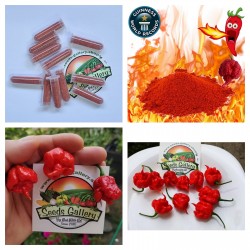
Порошок жатки Кароліни в...
Ціна
1,35 €
SKU: Z 5 CRPTT
Seeds Gallery Com,
5/
5
<h2><strong>Порошок жатки Кароліни в пробірці</strong></h2>
<h2><span style="color: #e03e2d;"><strong>1,8 г порошку в пробірці.</strong></span></h2>
<p><strong>Дуже практичний у використанні, ви завжди можете взяти з собою і приправити страву так, як вам хочеться ????<br>Як і кожного року, і цього року 2021 року ми знову матимемо 1200 наших рослин, з яких ми пропонуємо вам як насіння, так і мелену Кароліну Жнець.</strong></p>
<p>Extremely spicy Carolina Reaper is great for meats, rubs, fish, soups, and much more! The small-sized packets are an excellent way to try out how spicy they are.</p>
<p>The Carolina Reaper, originally named the HP22BNH7, is a cultivar of chili pepper of the Capsicum chinense species. Bred in the Rock Hill, South Carolina greenhouse by Ed Currie, who runs the PuckerButt Pepper Company in Fort Mill, South Carolina, it has been rated as the world's hottest chili pepper by Guinness World Records since August 7, 2013. The original crossbreed was between a ghost pepper (a former world record holder) and a red habanero. The official Guinness World Record heat level is 1,569,300 Scoville Heat Units (SHU), according to tests conducted by Winthrop University in South Carolina.</p>
<p>At the second annual New York City Hot Sauce Expo on 30 March 2014, Ed Currie was presented with his world record by Guinness World Records and an eating competition was held in which the fastest time to consume three Carolina Reapers was determined for a new Guinness World Records at 12.23 seconds by Russel Todd. This record was beaten in September 2014 by Jason McNabb, who finished three peppers in 10.95 seconds.</p>
<script src="//cdn.public.n1ed.com/G3OMDFLT/widgets.js"></script>
Z 5 CRPTT


Разнообразие из Перу
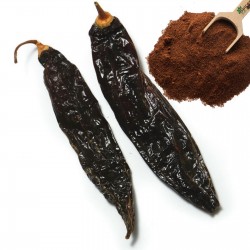
Порошок перуанського...
Ціна
1,65 €
SKU: Z 2 APP
Seeds Gallery Com,
5/
5
<h2><strong>Порошок перуанського чорного чилі Aji Panca</strong></h2>
<h2><span style="color: #f80000;"><strong>Ціна вказана за 5 грам порошку.</strong></span></h2>
Існує так багато способів, як можна використовувати пані чилі Ají. Зваріть його в супах, подрібніть і кидайте в салати або використовуйте як гарнір до різних м’ясних страв. Список рецептів пані чилі Ají майже нескінченний, головним чином тому, що це дуже популярний овоч у багатьох країнах, і кухарі завжди придумують інноваційні способи приготування пані чилі Ají.<br><br>У багатьох вегетаріанських меню Ají panca chili входить до десятки найкращих рослин, але цей поживний овоч також використовується в багатьох стравах на м’ясній основі.<script src="//cdn.public.n1ed.com/G3OMDFLT/widgets.js"></script>
Z 2 APP (5g)

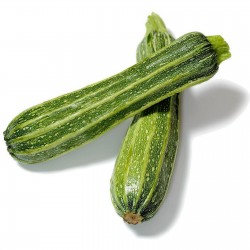
Романеско насіння цукіні
Ціна
1,95 €
SKU: VG 57
Seeds Gallery Com,
5/
5
<meta http-equiv="Content-Type" content="text/html; charset=UTF-8" />
<h2><strong>Романеско насіння цукіні</strong></h2>
<h2><span style="color: #ff0000;"><strong>Ціна за упаковку з 10 насінин.</strong></span></h2>
<p>Старий урожайний італійський сорт, який дає багато зелених ребристих плодів довжиною 30-40 см протягом усього сезону, що дуже смачно, має дуже приємний горіховий смак і присутність, яка перевершує світ звичайних кабачків.</p>
<p>Також із цим сортом ви можете з’їсти квітку, яка така ж смачна, як кабачок.</p>
<p>Деякі джерела перелічують цей старий сорт як Костата Романеска, або "ребриста римська". В Італії його збирають рано завдовжки 15 см, при цьому квітка все ще прикріплена.</p>
<p>Від сівби до плодоношення проходить 55 днів.</p>
<p>
<script type="text/javascript"></script>
</p>
VG 57 (10 S)


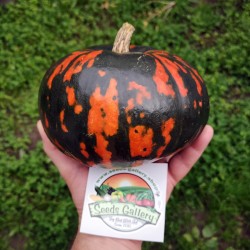
Чорний Хоккайдо гарбузове...
Ціна
2,45 €
SKU: VG 4
Seeds Gallery Com,
5/
5
<h2><strong>Чорний Хоккайдо гарбузове насіння</strong></h2>
<h2><span style="color: #ff0000;" class=""><strong>Ціна за упаковку з 10 (2g) насінин.</strong></span></h2>
<p>Чорний Хоккайдо - красивий рідкісний кабачок (гарбуз) чорно-оранжевого кольору, який має вигляд маленького гарбуза без хребтів.</p>
<p>Чорний гарбуз хоккайдо, що походить з острова Хоккайдо, важить 1-2 кг і має м’яку м’якоть з низьким вмістом клітковини з трохи горіховою ноткою. Софтшелл можна їсти. У гарбузі Хоккайдо тверде м’ясо, хоча він бідний водою, проте має всі цінніші поживні речовини, такі як вітаміни А і С, калій і магній.</p>
<p>Кабачок чорний Хоккайдо - культивований сорт виду Cucurbita maxima.</p><script src="//cdn.public.n1ed.com/G3OMDFLT/widgets.js"></script>
VG 4 (2g)


